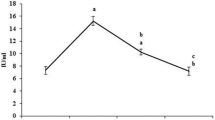Summary
Effects of 3,4,3′,4′-tetrachlorobiphenyl (TCB) on glucose-6-phosphatase (G6Pase)-altered hepatic foci of N-nitrosomorpholine (NNM)-treated B6C3F1 mice were investigated. TCB was chosen as a selective 3-methylcholanthrene-type inducer and tumor promoter. To initiate hepatocarcinogenesis, mice were treated with NNM (160 mg/l, in drinking water for 7 weeks), as in previous studies with the rat model. After a treatment-free interval of 22 weeks, TCB was administered (5×50 mg/kg, every 3 days), and liver foci were analysed 10 weeks after the start of TCB treatment. Unexpectedly, the number of G6Pase-negative and-positive foci per liver was markedly diminished following TCB treatment (to 32% and 57%, respectively). On the other hand, the mean volume of the remaining G6Pase-altered foci was enhanced, owing to an increase in the percentage of foci of large size (>0.5mm2). Throughout the experimental period of 39 weeks prolonged liver injury due to NNM and TCB treatment was demonstrated by histology and by elevated serum levels of glutamate-oxaloacetate transaminase. The results suggest that (in contrast to the rat system) TCB exhibited opposing effects on liver foci in the mouse model: (a) moderate tumor-promoting effects and (b) cytotoxic effects in NNM-injured liver, leading to decreased numbers of liver foci.
Similar content being viewed by others
Abbreviations
- G6Pase:
-
glucose-6-phosphatase
- NNM:
-
N-nitrosomorpholine
- TCB:
-
3,4,3′,4′-tetrachlorobiphenyl
References
Bannasch P, Müller HA (1964) Lichtmikroskopische Untersuchungen über die Wirkung von N-Nitrosomorpholin auf die Leber von Ratte und Maus. Arzneimittelforschung 14:805–814
Berenblum I, Shubik P (1947) The role of croton oil applications, associated with a single painting of a carcinogen, in tumour induction of the mouse's skin. Br J Cancer 1:379–382
Bock KW, White INH (1974) UDP-glucuronyltransferase in perfused rat liver and in microsomes: Influence of phenobarbital and 3-methylcholanthrene. Eur J Biochem 46:451–459
Bock KW, Lilienblum W, Pfeil H (1982) Functional heterogeneity of UDP-glucuronosyltransferase activities in C57BL/6 and DBA/2 mice. Biochem Pharmacol 31:1273–1277
Buchmann A, Kunz W, Wolf CR, Oesch F, Robertson LW (1986) Polychlorinated biphenyls, classified as either phenobarbital- or 3-methylcholanthrene-type inducers of cytochrome P-450, are both hepatic tumor promoters in diethylnitrosamine-initiated rats. Cancer Lett 32:243–253
Campbell HA, Pitot HC, Potter VR, Laishes BA (1982) Application of quantitative stereology to evaluation of enzyme-altered foci in rat liver. Cancer Res 42:465–472
Dyroff M, Richardson FC, Popp JA, Bedell MA, Swenberg JA (1986) Correlation of O 4-ethyldeoxythymidine accumulation, hepatic initiation and hepatocellular carcinoma induction in rats continuously administered diethylnitrosamine. Carcinogenesis 7:241–246
Farber E (1984) Cellular biochemistry of the stepwise development of cancer with chemicals. Cancer Res 44:5463–5474
Farber E, Cameron R (1980) The sequential analysis of cancer development. Ado Cancer Res 31:125–226
Gössner W, Friedrich-Freksa H (1964) Histochemische Untersuchungen über die Glukose-6-Phosphatase in der Rattenleber während der Cancerisierung durch Nitrosamine. Z naturforsch 19b:862–864
Moore MR, Drinkwater NR, Miller EC, Miller JA, Pitot HC (1981) Quantitative analysis of the time-dependent development of glucose-6-phosphatase-deficient foci in the livers of mice treated neonatally with diethylnitrosamine. Cancer Res 41:1585–1593
Moore MA, Mayer D, Bannasch P (1982) The dose dependence and sequential appearance of putative preneoplastic populations induced in the rat liver by stop experiments with N-nitrosomorpholine. Carcinogenesis 3:1429–1436
Nebert DW, (1988) The 1986 Bernard B. Brodie award lecture. The genetic regulation of drug-metabolizing enzymes. Drug Metab Dispos 16:1–8
Pitot HC, Sirica AE (1980) The stages of initiation and promotion in hepatocarcinogenesis. Biochim Biophys Acta 605:191–215
Pitot HC, Goldsworthy TL, Campbell HA, Poland A (1980) Quantitative evaluation of the promotion by 2,3,7,8-tetrachlorodibenzo-p-dioxin of hepatocarcinogenesis from diethylnitrosamine. Cancer Res 40:3616–3620
Pitot HC, Goldsworthy TL, Moran S, Kennan W, Glauert HP, Maronpot RR, Campbell HA (1987) A method to quantitate the relative initiation and promoting potencies of hepatorcarcinogenic agents in their dose-response relationship to altered hepatic foci. Carcinogenesis 8:1491–1499
Poland A, Knutson JC (1982) 2,3,7,8-Tetrachlorodibenzo-p-dioxin and related halogenated aromatic hydrocarbons: examination of the mechanism of toxicity. Annu Rev Pharmacol Toxicol 22:517–554
Reitman S, Frankel S (1957) A colorimetric method for the determination of serum glutamic oxaloacetic and serum glutamic pyruvic transaminases. Am J Clin Pathol 28:56–59
Rous P, Kidd JG (1941) Conditional neoplasms and subthreshold neoplastic states. J Exp Med 73:365–395
Scherer E (1984) Neoplastic progression in experimental hepatocarcinogenesis. Biochim Biophys Acta 738:219–236
Schulte-Herrmann R, Ohde G, Schuppler J, Timmermann-Trosiener, I (1981) Enhanced proliferation of putative preneoplastic cells in rat liver following treatment with the tumor promoters phenobarbital, hexachlorocyclohexane, steroid compounds and nafenopin. Cancer Res 41:2556–2562
Ullrich V, Weber P (1972) The O-dealkylation of 7-ethoxy-coumarin by liver microsomes. Hoppe-Seyler's Z Physiol Chem 353:1171–1177
Wachstein M, Meisel E (1957) On the histochemical demonstration of glucose-6-phosphatase. J Histochem Cytochem 4:592
Williams GM, Numoto S (1984) Promotion of mouse liver neoplasms by the organochlorine pesticides chlordane and heptachlor in comparison to dichlorodiphenyltrichlorethane. Carcinogenesis 5:1689–1696
Wölfle D, Münzel P, Fischer G, Bock KW (1988) Altered growth control of rat hepatocytes after treatment with 3,4,3′,4′-tetrachlorobiphenyl in vivo and in vitro. Carcinogenesis 9:919–924
Author information
Authors and Affiliations
Rights and permissions
About this article
Cite this article
Kobusch, A.B., Fischer, G. & Bock, K.W. Tumor-promoting activity and cytotoxicity of 3,4,3′,4′-tetrachlorobiphenyl on N-nitrosomorpholine-induced murine liver foci. J Cancer Res Clin Oncol 115, 247–252 (1989). https://doi.org/10.1007/BF00391697
Received:
Accepted:
Issue Date:
DOI: https://doi.org/10.1007/BF00391697




